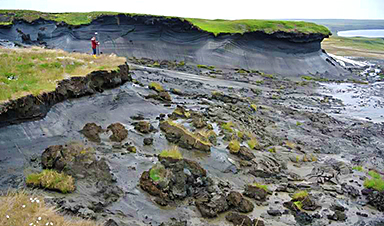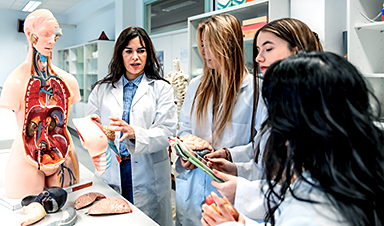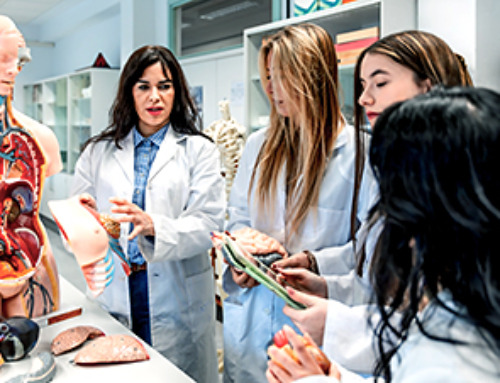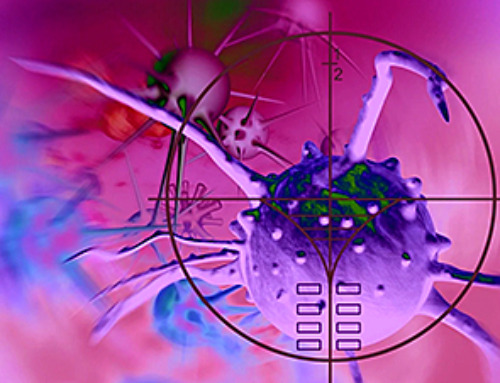Among the many things global warming will be melting this century—sea ice, land glaciers and tourist businesses in seaside towns across the world—is permafrost. Lying underneath 15% of the northern hemisphere, permafrost consists of accumulating dead biomass that remains frozen, never having had a chance to release all its carbon.
As the surface and lower atmosphere warms from human enhancement of the greenhouse effect, crucial questions are how much permafrost will thaw and how much carbon will that release into the atmosphere?
It’s a question complicated by the many processes that take place in the carbon cycle. Now a new study using a process-based biogeochemical model combining the science with observational data suggests the majority of thawed permafrost carbon will remain sequestered in layers that have been frozen, but this will create a significant challenge to future climate change mitigation efforts if the thawing accelerates.
The work, by four scientists in China and one at Purdue University in the US, is published in the journal Earth’s Future.
Permafrost forms mostly where the annual average temperature is below the freezing point of water. If that average is below -5°C, the freezing can be permanent at today’s climate level. (It was much more extensive during the Last Glacial Maximum.)
Making this problem worse is warming amplification at the Earth’s poles—the fact that global warming isn’t evenly distributed over the surface of the globe but increases with latitude. For example, the Arctic has warmed nearly four times faster than has the global average since 1979.
Thawing permafrost would act as a positive feedback to warming—adding to global warming via emissions of carbon dioxide—with the amount depending on how much anthropogenic forcing of climate takes place. With about 1 trillion tons of permafrost ultimately vulnerable to global climate change, modeling its future is a complex business.
Researchers have been working at reducing the uncertainties in the process, which include differences in regional amounts of thawing (which can also undermine buildings and communities), a dearth of observational data in remote regions, changes in vegetation coverage (which may absorb some of the emitted carbon), unpredictable weather extremes and wildfires, and what the paper’s authors describe as “the complex and unique water, energy, carbon, and nutrient interactions among the atmosphere, plants, soils, frozen layers, and microbes.”
Most of all, the amount of carbon thawing permafrost will emit into the atmosphere depends on what socioeconomic path humanity takes into the future. (Meaning any model result is necessarily a projection based on assumed parameters, not a prediction.)
The team considered two established scenarios of the future, the so-called Shared Socioeconomic Pathways (SSPs)—one, SSP126 (earlier: RCP2.6), an optimistic scenario of the future that limits global warming to 2.0°C, and the other, SSP585 (RCP8.5), being the most extreme scenarios where fossil fuel use remains business as usual and provides the vast majority of the future’s energy.
It also incorporated profiles of soil organic carbon using data sets based on observations. After validating their model, they applied it to permafrost thaw in the Northern Hemisphere for the rest of this century.
The new model estimated the permafrost area for the Northern Hemisphere for 2010 to 2015 to be 14.4 million square kilometers, containing 563 gigatons (Gt) of carbon in the latter year. For the SSP126 scenario that limits warming to 2.0°C, the model determined that permafrost degradation would make 119 Gt of carbon available for decomposition by 2100 from soil that was permanently frozen, reducing the carbon in permafrost ecosystems by 3.4 Gt. For the extreme SSP585 scenario, 252 Gt of carbon would become available, reducing the same carbon ecosystem by 15 Gt of carbon.
However, the model found that only about 4% to 8% of this newly thawed carbon is expected to be released into the atmosphere by 2100, a fraction that is within a range estimated by experts in 2015. This implies a maximum of 10 Gt of carbon for the least impactful scenario and 20 Gt of carbon for the most extreme scenario.
For comparison, in 2023, humans emitted 11.3 Gt of carbon from burning fossil fuels, land use changes, raising cattle and other activities, about half of which stays in the atmosphere for years. At present there is 880 Gt of carbon in the atmosphere, 300 Gt of which has been added by humans.
So thawing permafrost does not, in this model, appear to be a serious problem this century. However, degradation of permafrost increases nitrogen availability in soil, as decomposing previously frozen organic matter releases nitrogen in forms plants can use, and nitrogen stored in deeper soil layers is mobilized.
This can significantly increase plant growth and the dynamics of ecosystems. This is a negative, though small, feedback to global warming—in this model by Liu and his team, permafrost thaw increased the nitrogen stock in vegetation by 10 and 26 million tons in the two scenarios, and the carbon stock in vegetation by 0.4 and 1.6 Gt of carbon in the respective scenarios.
While this carbon increase does not compensate for the carbon loss from degrading permafrost, such permafrost thaw has already led to significant changes in plant species composition and growth. Other changes are more complicated.
For warming to cease, human emissions must drop to zero—it’s not enough that they level off at a constant value. As long as warming continues, more and more permafrost will thaw, adding to mitigation challenges this century and larger feedback problems in the 2100s.
The largest uncertainties in warming are in high latitudes and high altitudes, and deeper complications like “abrupt thaw, root deepening and microbial colonization may accelerate the decomposition of this vast amount of thawed [soil organic carbon] in deep soils” the group writes, incorporating ever more nuances into the carbon and nitrogen cycles to better quantify carbon loss in permafrost soils.
As ever, the largest uncertainty will be the actions of man.
More information: L. Liu et al, The Fate of Deep Permafrost Carbon in Northern High Latitudes in the 21st Century: A Process‐Based Modeling Analysis, Earth’s Future (2024). DOI: 10.1029/2024EF004996
Journal information: Earth’s Future
News
Repurposed drugs could calm the immune system’s response to nanomedicine
An international study led by researchers at the University of Colorado Anschutz Medical Campus has identified a promising strategy to enhance the safety of nanomedicines, advanced therapies often used in cancer and vaccine treatments, [...]
Nano-Enhanced Hydrogel Strategies for Cartilage Repair
A recent article in Engineering describes the development of a protein-based nanocomposite hydrogel designed to deliver two therapeutic agents—dexamethasone (Dex) and kartogenin (KGN)—to support cartilage repair. The hydrogel is engineered to modulate immune responses and promote [...]
New Cancer Drug Blocks Tumors Without Debilitating Side Effects
A new drug targets RAS-PI3Kα pathways without harmful side effects. It was developed using high-performance computing and AI. A new cancer drug candidate, developed through a collaboration between Lawrence Livermore National Laboratory (LLNL), BridgeBio Oncology [...]
Scientists Are Pretty Close to Replicating the First Thing That Ever Lived
For 400 million years, a leading hypothesis claims, Earth was an “RNA World,” meaning that life must’ve first replicated from RNA before the arrival of proteins and DNA. Unfortunately, scientists have failed to find [...]
Why ‘Peniaphobia’ Is Exploding Among Young People (And Why We Should Be Concerned)
An insidious illness is taking hold among a growing proportion of young people. Little known to the general public, peniaphobia—the fear of becoming poor—is gaining ground among teens and young adults. Discover the causes [...]
Team finds flawed data in recent study relevant to coronavirus antiviral development
The COVID pandemic illustrated how urgently we need antiviral medications capable of treating coronavirus infections. To aid this effort, researchers quickly homed in on part of SARS-CoV-2's molecular structure known as the NiRAN domain—an [...]
Drug-Coated Neural Implants Reduce Immune Rejection
Summary: A new study shows that coating neural prosthetic implants with the anti-inflammatory drug dexamethasone helps reduce the body’s immune response and scar tissue formation. This strategy enhances the long-term performance and stability of electrodes [...]
Scientists discover cancer-fighting bacteria that ‘soak up’ forever chemicals in the body
A family of healthy bacteria may help 'soak up' toxic forever chemicals in the body, warding off their cancerous effects. Forever chemicals, also known as PFAS (per- and polyfluoroalkyl substances), are toxic chemicals that [...]
Johns Hopkins Researchers Uncover a New Way To Kill Cancer Cells
A new study reveals that blocking ribosomal RNA production rewires cancer cell behavior and could help treat genetically unstable tumors. Researchers at the Johns Hopkins Kimmel Cancer Center and the Department of Radiation Oncology and Molecular [...]
AI matches doctors in mapping lung tumors for radiation therapy
In radiation therapy, precision can save lives. Oncologists must carefully map the size and location of a tumor before delivering high-dose radiation to destroy cancer cells while sparing healthy tissue. But this process, called [...]
Scientists Finally “See” Key Protein That Controls Inflammation
Researchers used advanced microscopy to uncover important protein structures. For the first time, two important protein structures in the human body are being visualized, thanks in part to cutting-edge technology at the University of [...]
AI tool detects 9 types of dementia from a single brain scan
Mayo Clinic researchers have developed a new artificial intelligence (AI) tool that helps clinicians identify brain activity patterns linked to nine types of dementia, including Alzheimer's disease, using a single, widely available scan—a transformative [...]
Is plastic packaging putting more than just food on your plate?
New research reveals that common food packaging and utensils can shed microscopic plastics into our food, prompting urgent calls for stricter testing and updated regulations to protect public health. Beyond microplastics: The analysis intentionally [...]
Aging Spreads Through the Bloodstream
Summary: New research reveals that aging isn’t just a local cellular process—it can spread throughout the body via the bloodstream. A redox-sensitive protein called ReHMGB1, secreted by senescent cells, was found to trigger aging features [...]
AI and nanomedicine find rare biomarkers for prostrate cancer and atherosclerosis
Imagine a stadium packed with 75,000 fans, all wearing green and white jerseys—except one person in a solid green shirt. Finding that person would be tough. That's how hard it is for scientists to [...]
Are Pesticides Breeding the Next Pandemic? Experts Warn of Fungal Superbugs
Fungicides used in agriculture have been linked to an increase in resistance to antifungal drugs in both humans and animals. Fungal infections are on the rise, and two UC Davis infectious disease experts, Dr. George Thompson [...]





















